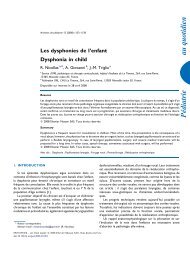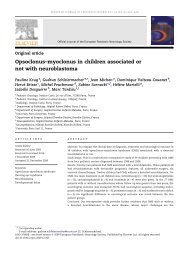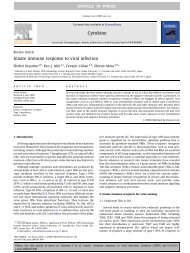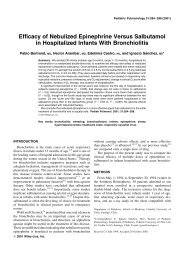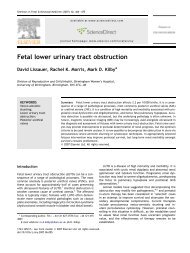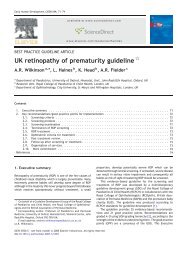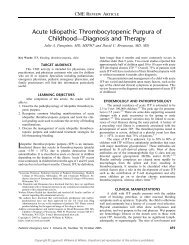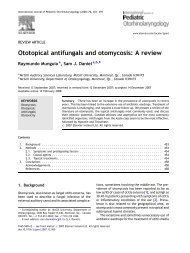Premature Adrenarche - sepeap
Premature Adrenarche - sepeap
Premature Adrenarche - sepeap
Create successful ePaper yourself
Turn your PDF publications into a flip-book with our unique Google optimized e-Paper software.
Original Article<br />
<strong>Premature</strong><br />
<strong>Adrenarche</strong><br />
Alexander K.C. Leung, MBBS, FRCPC, FRCP(UK &<br />
Irel), FRCPCH, FAAP,<br />
& Wm. Lane M. Robson, MD, FRCPC, FRCP(Glasg)<br />
ABSTRACT<br />
<strong>Premature</strong> adrenarche refers to the precocious secretion of adrenal androgens,<br />
which results in the isolated development of pubic hair (pubarche) before the age<br />
of eight years in girls and nine years in boys. The female to male ratio is<br />
approximately 10:1. Dark, coarse and curly hair is limited initially to the labia<br />
majora in girls and to the root of the penis in boys. The hair extends gradually into<br />
the pubic region. Axillary hair, increased body odor, and acne can also be present.<br />
Hirsutism, deepening of the voice, clitoral enlargement, breast development, and<br />
phallic or testicular enlargement are characteristically absent. A transient acceleration<br />
of growth is common but final height is usually not affected. The onset of<br />
puberty usually occurs at the normal age. <strong>Premature</strong> adrenarche can be a forerunner<br />
of polycystic ovary syndrome and/or syndrome X. Continued observation<br />
and periodic re-evaluation is necessary. J Pediatr Health Care. (2008) 22, 230-233.<br />
Key words: <strong>Premature</strong> adrenarche, pubarche, polycystic ovary syndrome, syndrome<br />
X<br />
Alexander K. C. Leung is Clinical Associate Professor of Pediatrics, the University of<br />
Calgary, and Pediatric Consultant, the Alberta Children’s Hospital, Calgary, Alberta,<br />
Canada.<br />
Wm. Lane M. Robson is Medical Director, The Children’s Clinic, Calgary, Alberta,<br />
Canada.<br />
Correspondence: Alexander K. C. Leung, MBBS, FRCPC, FRCP(UK & Irel), FRCPCH,<br />
FAAP, #200, 233 - 16th Ave NW, Calgary, Alberta, Canada T2M 0H5; e-mail:<br />
aleung@ucalgary.ca.<br />
0891-5245/$34.00<br />
Copyright © 2008 by the National Association of Pediatric Nurse Practitioners.<br />
doi:10.1016/j.pedhc.2007.07.002<br />
www.jpedhc.org<br />
INTRODUCTION<br />
<strong>Adrenarche</strong> refers to the puberty<br />
of the adrenal gland (Ibanez, DiMartino-Nardi,<br />
Potau, & Saenger, 2000).<br />
The condition is characterized by activation<br />
of adrenal androgen production<br />
and by impressive increases<br />
in dehydroepiandrosterone (DHEA),<br />
dehydroepiandrosterone sulfate<br />
(DHEAS), androstenedione, and<br />
testosterone (Guven, Cinaz, & Ayvali,<br />
2005; Ibanez et al.). <strong>Adrenarche</strong><br />
is an enigmatic phenomenon<br />
that occurs only in humans<br />
and some higher primate species<br />
such as the chimpanzee and gorilla<br />
(Auchus & Rainey, 2004; Saenger<br />
& DiMartino-Nardi, 2001). <strong>Premature</strong><br />
or precocious adrenarche refers<br />
to an earlier than normal secretion<br />
of adrenal androgens that<br />
results in an isolated development<br />
of pubic hair (pubarche) before 8<br />
years of age in girls and 9 years in<br />
boys, without the appearance of<br />
other signs of sexual maturation<br />
(Ibanez et al.; Saenger & DiMartino-Nardi).<br />
Precocious development<br />
of pubic hair can cause embarrassment<br />
to the child and<br />
anxiety to the parents. Clinicians<br />
should be concerned because premature<br />
adrenarche can be the first<br />
overt sign of an androgen-secreting<br />
tumor of a gonad or adrenal<br />
gland, congenital adrenal hyperplasia,<br />
or true precocious puberty.<br />
Recent studies suggest that premature<br />
adrenarche in some girls can<br />
be a forerunner of polycystic ovary<br />
syndrome and/or syndrome X<br />
(Andiran, Yordam, & Kirazh, 2005;<br />
Dorn & Rotenstein, 2004; Saenger<br />
& DiMartino-Nardi, 2001).<br />
EPIDEMIOLOGY<br />
<strong>Premature</strong> adrenarche is uncommon.<br />
In a cross-sectional study of<br />
1231 school girls of Eastern European<br />
origin, only 2 (0.8%) of 255<br />
girls aged 7 to 7.9 years were<br />
found to have premature adrenarche<br />
(Zukauskaite, Lasiene, Lasas,<br />
Urbonaite, & Hindmarch, 2005).<br />
230 Volume 22 • Number 4 Journal of Pediatric Health Care
...premature adrenarche can be the first overt<br />
sign of an androgen-secreting tumor of a<br />
gonad or adrenal gland, congenital adrenal<br />
hyperplasia, or true precocious puberty.<br />
FIGURE 1. A 6-year-old girl<br />
with isolated development of<br />
pubic hair. This figure can be<br />
viewed in color on the Web at<br />
www.jpedhc.org.<br />
Black children are affected much<br />
more frequently than are White children<br />
(Banerjee et al., 1998). The female-to-male<br />
ratio is approximately<br />
10:1 (Dorn & Rotenstein, 2004;<br />
Saenger & DiMartino-Nardi, 2001).<br />
Both prematurity and intrauterine<br />
growth retardation might predispose<br />
to premature adrenarche in a susceptible<br />
individual (Charkaluk,<br />
Trivin, & Brauner, 2004; Neville &<br />
Walker, 2005). Excess weight gain<br />
might be a trigger for adrenarche,<br />
and obesity is reported to be associated<br />
with a higher incidence of<br />
premature adrenarche (Ibanez et<br />
al., 2000; Leung & Robson, in<br />
press; Neville & Walker, 2005; Remer,<br />
2000). The occurrence of premature<br />
adrenarche usually is sporadic,<br />
although familial occurrence<br />
also has been described (Leung,<br />
1989).<br />
PATHOGENESIS<br />
<strong>Adrenarche</strong> begins several years<br />
before the onset of gonadal maturation<br />
and correlates with the appearance<br />
of the zona reticularis of<br />
the adrenal gland. <strong>Adrenarche</strong> is<br />
independent of gonadarche and<br />
proceeds even in persons with gonadal<br />
dysgenesis. In normal puberty,<br />
adrenarche and gonadarche<br />
are closely linked. <strong>Premature</strong> adrenarche<br />
is secondary to an early isolated<br />
maturation of the zona reticularis<br />
with an increase in adrenal<br />
androgen secretion for the chronologic<br />
age but with normal glucocorticoid<br />
levels (Azziz et al.,<br />
2004; Meas et al., 2002). Oversecretion<br />
of adrenocorticotropic hormone<br />
(ACTH) or corticotropin-releasing<br />
hormone (CRH) per se<br />
cannot account for premature<br />
adrenarche because ACTH always<br />
causes a greater increase in corticosteroids<br />
than in androgens. In patients<br />
with hyperadrenocorticotropism<br />
and hypercortisolemia, DHEA<br />
and DHEAS levels usually are not<br />
elevated. Nevertheless, ACTH and<br />
CRH might have a permissive role in<br />
the modulation of adrenal androgen<br />
secretion (Saenger & DiMartino-<br />
Nardi, 2001). An increase of a central<br />
androgen–stimulating proopiomelanocortin-derived<br />
hormone might be<br />
the primum movens of premature<br />
adrenarche (Battaglia et al., 2002).<br />
Increased sensitivity of the sexual<br />
hair follicles to androgens also<br />
has been suggested as a mechanism<br />
because in some patients,<br />
premature pubarche is associated<br />
with normal androgen levels (Guven<br />
et al., 2005; Ibanez et al., 2000).<br />
This phenomenon might account<br />
for the increased prevalence of premature<br />
adrenarche among Black<br />
children (Banerjee et al., 1998). The<br />
association of premature adrenarche<br />
with prematurity and intrauterine<br />
growth retardation suggests<br />
that premature adrenarche<br />
might be a component of a fetal or<br />
neonatal programming event (Auchus<br />
& Rainey, 2004).<br />
CLINICAL MANIFESTATIONS<br />
The frequency of premature<br />
adrenarche increases with age between<br />
3 and 8 years of age in girls<br />
and between 3 and 9 years of age<br />
in boys, although cases have been<br />
reported as early as 5 weeks of age<br />
(Leung, 1989). Dark, coarse, and<br />
often curly hair is the first clinical<br />
sign. The hair is limited initially to<br />
the labia majora in girls or to the<br />
root of the penis in boys and then<br />
extends gradually into the pubic<br />
region (Figure 1). The amount and<br />
thickness of the hair might<br />
progress very slowly or not at all.<br />
Axillary hair, increased body odor,<br />
oily skin, and acne also might be<br />
noted (Ghizzoni & Milani, 2000;<br />
Ibanez et al., 2000). Acanthosis<br />
nigricans is more common in patients<br />
with premature adrenarche<br />
(DiMartino-Nardi, 2000). Hirsutism,<br />
deepening of the voice, clitoral<br />
enlargement, breast development,<br />
phallic or testicular enlargement,<br />
and other evidence of virilization<br />
or precocious puberty characteristically<br />
are absent.<br />
A transient acceleration of growth<br />
is common, but final height usually<br />
is not affected (Battaglia et al., 2002;<br />
Ghizzoni & Milani, 2000). The onset<br />
of puberty usually occurs at the normal<br />
age (Battaglia et al.; Ibanez et al.,<br />
2000).<br />
DIFFERENTIAL DIAGNOSIS<br />
<strong>Premature</strong> adrenarche is a diagnosis<br />
of exclusion. The differential<br />
diagnosis of premature development<br />
of pubic hair is shown in the<br />
Table. Pubic hair of infancy presumably<br />
is due to transiently elevated<br />
androgen levels in the first<br />
few months of life and increased<br />
sensitivity of sexual hair follicles to<br />
androgens (Leung, Hedge, & Stephure,<br />
2005; Nebesio & Eugster,<br />
2006). Shortly after birth, a transient<br />
surge of gonadotropins occurs<br />
and leads to a sharp increase in testosterone<br />
levels, which peaks at 1 to<br />
Journal of Pediatric Health Care July/August 2008<br />
231
TABLE. Differential diagnosis of premature development<br />
of pubic hair<br />
Condition<br />
Pubic hair of infancy<br />
<strong>Premature</strong> adrenarche<br />
Precocious puberty<br />
Virilizing tumors<br />
Late-onset congenital<br />
adrenal hyperplasia<br />
Iatrogenic<br />
3 months of age (Leung et al.).<br />
Thereafter, the gonadotropin levels<br />
fall, and by 6 months of age, serum<br />
levels of testosterone decrease to<br />
low prepubertal levels. In pubic<br />
hair of infancy, pubic hair usually<br />
occurs in an atypical location such<br />
as the scrotum in boys and the<br />
mons pubis in girls (Leung et al.;<br />
Nebesio & Eugster). The growth of<br />
the pubic hair is slowly progressive<br />
in the first few months of life,<br />
remains stationary for a few more<br />
months, and then might regress.<br />
Precocious puberty can be differentiated<br />
by the concomitant appearance<br />
of pubic hair with breast<br />
development in girls or with testicular<br />
enlargement in boys. <strong>Premature</strong><br />
adrenarche is extremely difficult,<br />
if not impossible, to differentiate<br />
from the early stage of constitutional<br />
precocious puberty.<br />
Sexual hair might be the first<br />
sign of virilization due to an adrenocortical<br />
or gonadal tumor. In<br />
these conditions, other evidence of<br />
excessive androgen secretion such<br />
as acne, clitoral or phallic enlargement,<br />
hirsutism, increased muscle<br />
mass, markedly accelerated linear<br />
growth, and deepening of the<br />
voice usually appear at the same<br />
time or shortly after the onset of<br />
Characteristics<br />
Pubic hair usually occurs in an atypical location such as<br />
scrotum in boys and mons pubis in girls; the growth of pubic<br />
hair is slowly progressive in the first few months of life,<br />
remains stationary for a few months, and then might regress<br />
Isolated development of pubic hair without the appearance of<br />
other signs of sexual maturation; the onset of puberty is<br />
normal<br />
Concomitant appearance of pubic hair with breast<br />
development in girls or with testicular enlargement in boys<br />
Acne, clitoral or phallic enlargement, hirsutism, markedly<br />
accelerated linear growth, and deepening of the voice at the<br />
same time or shortly after the onset of pubic hair<br />
development<br />
In addition to premature development of sexual hair, hirsutism<br />
and menstrual irregularities are usually present; in the male,<br />
the testes usually remain infantile but other secondary sexual<br />
characteristics are advanced; a positive family history is<br />
suggestive<br />
A history of androgen exposure will give a clue to the diagnosis<br />
pubic hair development. In boys<br />
with an adrenocortical tumor, the<br />
testicular size is usually small,<br />
whereas the reverse is true for<br />
boys with a testicular tumor. Exogenous<br />
androgen can cause development<br />
of sexual hair as well as<br />
other signs of virilization. Obtaining<br />
a careful history about drug<br />
exposure is important.<br />
Congenital adrenal hyperplasia,<br />
usually resulting from 21-hydroxylase<br />
deficiency, classically produces<br />
prenatal virilization in females<br />
but can, in a late-onset<br />
attenuated form, present with premature<br />
development of sexual<br />
hair, hirsutism, and menstrual irregularities.<br />
In the male, the testes<br />
usually remain infantile, but other<br />
secondary sexual characteristics are<br />
advanced. A positive family history<br />
of congenital adrenal hyperplasia is<br />
suggestive.<br />
COMPLICATIONS<br />
Girls with premature adrenarche<br />
have a higher incidence of<br />
polycystic ovary syndrome later in<br />
life (Andiran et al., 2005; Auchus &<br />
Rainey, 2004; Ibanez et al., 2002).<br />
Polycystic ovary syndrome is characterized<br />
by menstrual irregularities,<br />
obesity, acne, hirsutism, and polycystic<br />
ovaries (DiMartino-Nardi, 2000).<br />
In some girls, premature adrenarche<br />
may be a forerunner of syndrome X<br />
(obesity, hypertension, insulin resistance,<br />
type 2 diabetes, and dyslipidemia)<br />
(Ibanez et al., 2000; Saenger &<br />
DiMartino-Nardi, 2001). Affected<br />
patients are at increased risk for<br />
early atherosclerotic cardiovascular<br />
disease (Saenger & DiMartino-<br />
Nardi). In contrast, premature adrenarche<br />
in boys is not associated with<br />
an increased incidence of endocrine<br />
or metabolic abnormalities (Dorn &<br />
Rotenstein, 2004; Ibanez et al.).<br />
DIAGNOSTIC STUDIES<br />
Serum concentrations of DHEA,<br />
DHEAS, androstenedione, and testosterone<br />
and urinary 17-ketosteroids<br />
should be measured. In premature<br />
adrenarche, these levels<br />
are usually increased for chronologic<br />
age and are in the range of<br />
those found in early puberty (Battaglia<br />
et al., 2002). DHEAS levels,<br />
however, might exceed those of<br />
pubertal controls (Ibanez et al.,<br />
2000). A bone age x-ray should be<br />
preformed. In premature adrenarche,<br />
the bone age is usually<br />
within 2 standard deviations of<br />
chronologic age.<br />
Moderately elevated levels of serum<br />
androgen other than DHEAS,<br />
bone age advancement, or signs of<br />
atypical premature pubarche such<br />
as cystic acne or signs of systemic<br />
virilization indicate the need for an<br />
ACTH test to rule out congenital adrenal<br />
hyperplasia (Ibanez et al.,<br />
2000). An excessive increase in<br />
serum 17-hydroxyprogesterone<br />
level to 45 nmol/L after an<br />
ACTH stimulation test suggests<br />
late-onset congenital adrenal hyperplasia<br />
(Battaglia et al., 2002).<br />
Marked elevation of serum androgen<br />
levels and advanced bone<br />
age suggest the possibility of an<br />
adrenocortical or gonadal tumor. A<br />
patient with an androgen-producing<br />
adrenocortical tumor does not respond<br />
to ACTH stimulation or dexamethasone<br />
suppression, whereas a<br />
patient with congenital adrenal hyperplasia<br />
does respond. Adrenal<br />
232 Volume 22 • Number 4 Journal of Pediatric Health Care
Marked elevation of serum androgen levels and<br />
advanced bone age suggest the possibility of an<br />
adrenocortical or gonadal tumor.<br />
computed tomography or ultrasonography<br />
should be performed if<br />
significant virilization occurs and<br />
ACTH stimulation does not reveal<br />
congenital adrenal hyperplasia (Rodriguez<br />
& Pescovitz, 2003).<br />
Pelvic ultrasonography should<br />
be performed if polycystic ovary<br />
syndrome is suspected. The presence<br />
of an enlarged ovary and multiple<br />
small follicles scattered around<br />
an echogenic stroma establishes the<br />
diagnosis (Battaglia et al., 2002).<br />
Color Doppler flow measurements<br />
might reveal significant vascular<br />
changes within the intra-ovarian<br />
vessels in patients with polycystic<br />
ovary syndrome (Battaglia et al.).<br />
Serum glucose, insulin, cholesterol,<br />
and triglyceride levels should be measured<br />
if syndrome X is suspected.<br />
MANAGEMENT<br />
Education and reassurance of<br />
the patient and family as well as<br />
psychological/emotional support<br />
for the child and family are essential<br />
to the clinical management of<br />
such patients. The parents and<br />
child should be reassured that, in<br />
most cases, premature adrenarche<br />
is a benign condition and that the<br />
child will develop normally. Continued<br />
observation and periodic<br />
re-evaluation are necessary because<br />
premature adrenarche might<br />
be the first sign of precocious puberty.<br />
In some girls, premature adrenarche<br />
might be a forerunner of<br />
polycystic ovary syndrome or syndrome<br />
X. Girls with higher body<br />
mass index warrant particularly<br />
close follow-up (Miller, Emans, &<br />
Kohane, 1996). Early identification<br />
of these patients can allow early<br />
treatment of the appropriate conditions<br />
with reduction in risk for early<br />
cardiovascular disease.<br />
REFERENCES<br />
Andiran, N., Yordam, N., & Kirazh, S.<br />
(2005). Global fibrinolytic capacity is<br />
decreased in girls with premature adrenarche:<br />
a new pathological finding?<br />
Journal of Pediatric Endocrinology and<br />
Metabolism, 18, 1373-1381.<br />
Auchus, R. J., & Rainey, W. E. (2004). <strong>Adrenarche</strong>—physiology,<br />
biochemistry and<br />
human disease. Clinical Endocrinology,<br />
60, 288-296.<br />
Azziz, R., Farah, L. A., Moran, C., Knochenhauer,<br />
E. S., Potter, H. D., & Boots,<br />
L. R. (2004). Early adrenarche in normal<br />
prepubertal girls: A prospective<br />
longitudinal study. Journal of Pediatric<br />
Endocrinology and Metabolism,<br />
17, 1231-1237.<br />
Banerjee, S., Raghavan, S., Wasserman,<br />
E. J., Linder, B. L., Saenger, P., &<br />
DiMartino-Nardi, J. (1998). Hormonal<br />
findings in African-American and Caribbean<br />
Hispanic girls with premature<br />
adrenarche: implications for polycystic<br />
ovary syndrome. Pediatrics, 102, e35.<br />
Battaglia, C., Regnani, G., Mancini, F.,<br />
Iughetti, L., Bernasconi, S., Volpe, A., et<br />
al. (2002). Isolated premature pubarche:<br />
Ultrasonographic and color Doppler<br />
analysis—a longitudinal study. The Journal<br />
of Clinical Endocrinology and Metabolism,<br />
87, 3148-3154.<br />
Charkaluk, M. L., Trivin, C., & Brauner, R.<br />
(2004). <strong>Premature</strong> pubarche as an indicator<br />
of how body weight influences the<br />
onset of adrenarche. European Journal<br />
of Pediatrics, 163, 89-93.<br />
DiMartino-Nardi, J. (2000). Pre- and postpubertal<br />
findings in premature adrenarche.<br />
Journal of Pediatric Endocrinology<br />
and Metabolism, 13, 1265-1269.<br />
Dorn, L. D., & Rotenstein, D. (2004). Early<br />
puberty in girls: The case of premature<br />
adrenarche. Women’s Health Issues,<br />
14, 177-183.<br />
Ghizzoni, L., & Milani, S. (2000). The natural<br />
history of premature adrenarche. Journal<br />
of Pediatric Endocrinology and Metabolism,<br />
13, 1247-1251.<br />
Guven, A., Cinaz, P., & Ayvali, E. (2005). Are<br />
growth factors and leptin involved in the<br />
pathogenesis of premature adrenarche<br />
in girls? Journal of Pediatric Endocrinology<br />
and Metabolism, 785-791.<br />
Ibanez, L., DiMartino-Nardi, J., Potau, N., &<br />
Saenger, P. (2000). <strong>Premature</strong> adrenarche—normal<br />
variant or forerunner of<br />
adult disease? Endocrine Reviews, 21,<br />
671-696.<br />
Ibanez, L., Valls, C., Ferrer, A., Ong, K.,<br />
Dunger, D., & de Zegher, F. (2002). Additive<br />
effects of insulin-sensitizing and<br />
anti-androgen treatment in young,<br />
nonobese women with hyperinsulinism,<br />
hyperandrogenism, dyslipidemia, and<br />
anovulation. Journal of Clinical Endocrinology<br />
and Metabolism, 87, 2870-<br />
2874.<br />
Leung, A. K. (1989). <strong>Premature</strong> pubarche.<br />
The Journal of the Singapore Paediatric<br />
Society, 31, 60-63.<br />
Leung, A. K., Hedge, H. R., & Stephure,<br />
D. K. (2005). Scrotal hair in identical<br />
twin infants. International Journal of<br />
Dermatology, 43,1042-1044.<br />
Leung, A. K., & Robson, W. L. (in press).<br />
Childhood obesity. In F. Columbus<br />
(Ed.), Childhood Nutrition Research<br />
Trends. Philadelphia: Nova Publishing.<br />
Meas, T., Chevenne, D., Thibaud, E., Leger,<br />
J., Cabrol, S., Czernichow, P., et al.<br />
(2002). Endocrine consequences of<br />
premature pubarche in post-pubertal<br />
Caucasian girls. Clinical Endocrinology,<br />
57, 101-106.<br />
Miller, D., Emans, S .J., & Kohane, I. (1996).<br />
Follow-up study of adolescent girls with<br />
a history of premature pubarche. Journal<br />
of Adolescent Health, 18, 301-305.<br />
Nebesio, T. D., & Eugster, E. (2006). Pubic<br />
hair of infancy: Endocrinopathy or<br />
enigma? Pediatrics, 117, 951-954.<br />
Neville, K. A., & Walker, J. L. (2005). Precocious<br />
pubarche is associated with SGA,<br />
prematurity, weight gain, and obesity. Archives<br />
of Disease in Childhood, 90, 258-<br />
261.<br />
Remer, T. (2000). <strong>Adrenarche</strong> and nutritional<br />
status. Journal of Pediatric Endocrinology<br />
and Metabolism, 13, 1253-<br />
1255.<br />
Rodriguez, H., & Pescovitz, O. H. (2003).<br />
Precocious puberty: Clinical management.<br />
In Radovick & S. MacGillivray<br />
(Eds.), M. H. Pediatric endocrinology: A<br />
practical clinical guide (pp. 399-428).<br />
New Jersey: Humana Press.<br />
Saenger, P., & DiMartino-Nardi, J. (2001).<br />
<strong>Premature</strong> adrenarche. Journal of<br />
Endocrinology Investigation, 24, 724-<br />
733.<br />
Zukauskaite, S., Lasiene, D., Lasas, L., Urbonaite,<br />
B., & Hindmarch, P. (2005).<br />
Onset of breast and pubic hair development<br />
in 1231 preadolescent Lithuanian<br />
schoolgirls. Archives of Disease in<br />
Childhood, 90, 932-936.<br />
Journal of Pediatric Health Care July/August 2008<br />
233






